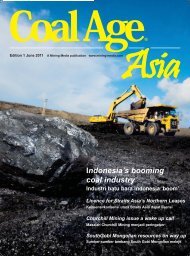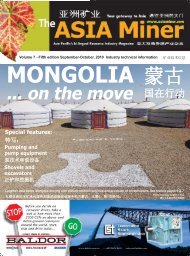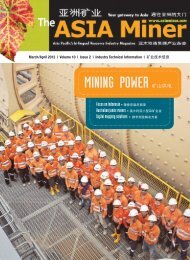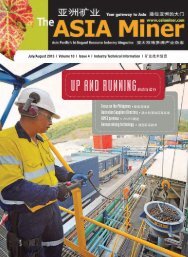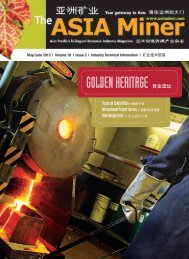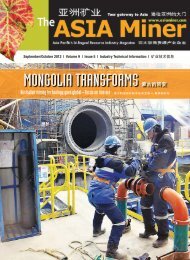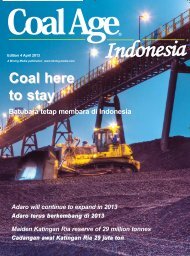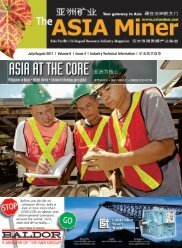Volume 9 Edition 3 2012 - The ASIA Miner
Volume 9 Edition 3 2012 - The ASIA Miner
Volume 9 Edition 3 2012 - The ASIA Miner
- No tags were found...
Create successful ePaper yourself
Turn your PDF publications into a flip-book with our unique Google optimized e-Paper software.
Beumer specializes in designing and building curved belt conveyors.and for closed, tubular belt conveyors.<strong>The</strong> company has been involved with various aspects of conveyor designsince its formation with its founder, Bernard Beumer, having inventedand patented a conveyor idler that featured a labyrinth seal. Fromthat starting point, successive generations of the Beumer family havebuilt the company to be a significant player in the international market.Under a recent contract, the company is supplying a troughed beltconveyor, capable of negotiating horizontal curves, to Nordkalk, one ofEurope’s major manufacturers of lime products. A key feature of Nordkalk’srequirements was for the limestone-transport system to be environmentallyfriendly, Beumer explains, with the 8.7-km long conveyorbeing installed in the north of the island of Gotland in the Baltic Sea.This, the company adds, is the largest limestone-production operationin Scandinavia, supplying limestone to customers around the BalticSea, with part of the quarry’s output being processed into quicklime byNordkalk’s subsidiary, KPAB.Every hour, 1,500 mt of limestone will be transported from a newquarry at Bunge to the plant in Storungs, where it will be gradedand stockpiled. “<strong>The</strong> Beumer troughed belt conveyor was a clear favoriteof ours compared to other transport options,” said Mikael Lindberg,plant manager for Nordkalk. “It uses little energy, is quiet andenvironmentally friendly.”Beumer notes it was crucial for Nordkalk to preserve the island’scountryside during transport. This goal was achieved, it says, becausethe troughed belt conveyor can navigate particularly tight horizontalcurves. This allows for flexible, continuous routing, and the opportunityto bypass sensitive areas or to negotiate obstacles such as rivers,streets, railways and so on, while preserving the existing terrain.Vibration Expertise for the World MarketHeadquartered in Dülmen, Jöst GmbH & Co. KG specializes in applyingvibration technology to handling and processing a wide variety of bulkmaterials. With more than 90 years’ experience, the company manufacturessophisticated machines and systems mainly based on vibrationtechnology, together with solutions for thermal processes.Looking specifically at Jöst’s vibration technology for the handlingof bulk materials in primary industries, it has a wide product range thatincludes the Extrovib system, grizzly screens and feeders, scalpingscreens, banana screens, classifying screens, dewatering screens, vibratingfeeders and drying systems. Its special screens include its Greccoscreens, Trampolin flip-flow screens, fine screens and non-blindingscreens among others, while it also has expertise in the design and supplyof electric control and regulation for machines and complete systems.<strong>The</strong> company says that screening technology is the centerpiece ofits product range. Aside from its main plant in Germany, Jöst manufacturesits machines and systems in Australia, China, France, India,South Africa and the U.S., with the Australian, Chinese and SouthAfrican activities being mainly focused on the production of heavy-dutyvibration screens and vibrating feeders.During 2011, Jöst won a major order for seven large feeders andscreens for Rio Tinto’s iron ore operations in the Pilbara region ofWestern Australia. <strong>The</strong> screens will be used at the Cape LambertPort B facility to sort lump ore and fines ahead of ship-loading. <strong>The</strong>new port facility will add 50 million mt/y of iron-ore capacity in phase1, with a second phase proposed to double capacity.Each double-deck screen, fully assembled and tested at Jöst Australia’sWelshpool facility, has a vibrating mass of 37.9 mt mounted onan isolation frame weighing 19.2 mt. Measuring 4.27 m wide, the screenswill be fed using diverging feeders to spread the ore over the full width ofthe screen, thereby using the maximum available surface area. <strong>The</strong> screendesign was developed ‘in-house,’ Jöst says, using finite element modelsthat were checked against factory test results using strain-gauge recordingsfor verification. Fully modal analysis was also undertaken to ensurea full understanding of the frequency responses of the screens.In another application, Jöst recently delivered a high-capacityscreening system for a new port complex that serves as a central distributionpoint for coal supplies to a certain country’s power plants andsteel mills. <strong>The</strong> installation comprised two high-capacity screens togetherwith discharge and distribution feeders.Two linear oscillators, constructed as vibratory banana-typescreens, are used for the screening function. <strong>The</strong> screens have a screeningarea of 4.0x8.3 m (33.2 m 2 ) each. <strong>The</strong> special slotted grid systemused gives high throughput rates and can be quickly replaced becauseof its segment-shaped design. <strong>The</strong> company explains that differentconveying rates on the screen are achieved because of the variousscreen-deck angles, so the product layer remains thin and bridging resultingfrom material pressure is avoided.Heavy-duty vibrating screens is one area of Jöst’s specialization.VDMA<strong>2012</strong> • VDMA MINING SUPPLEMENTVDMA 9



